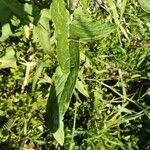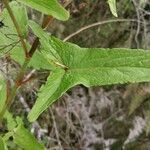A stout herb. It keeps growing from year to year. It grows 4 m tall. The rhizome or underground stem is fleshy. The stem is red-green and grooved. It is 3 cm across. The leaf blade is triangle shape. The leaves at the base are 25 cm long by 20 cm wide. The leaves on the stem are smaller. The group of flowers are 50 cm long. The flowers are in small clusters. The fruit is a sharply triangle shaped nut. It is 2-4 mm long and shiny.
Leaf lamina 6–18(34) × 5–16(29) cm, usually triangular-hastate, sometimes sagittate, scutate, sublinear or more rarely ovate; acute or subacute at the apex, hastate, subcordate or subobtuse at the base, with a variably deep and wide basal sinus, glabrous or undersurface ± pubescent; primary nerves 5–7, palmately arranged; petiole up to 14 cm long, those of the lower leaves often exceeding the lamina.
Outer perianth segments brown, 1.5 mm long, ovate-lanceolate, membranous, later reflexing; inner perianth segments green becoming reddish-brown, accrescent, 5.5–7 × 4.5–6 mm, suborbicular, cordate-emarginate at the base, rounded at the apex, entire, membranous, pellucid, strongly reticulate-veined, with a minute reflexed dorsal tubercle near the base.
Flowers hermaphrodite or polygamous, pedicellate, borne in fascicles in leafless terminal panicles; panicles ± branched, up to 30–50 × 25–35 cm, cylindrical or pyramidal in outline.
Herb with stout perennial rootstock, 1 in. diam.; stems annual, up to several feet high.
Stems green or reddish-green, erect, up to 4 m tall, glabrous, hollow, striate.
Nut pale or dark brown, smooth and shiny, 2.5–3 × 1.8–2 mm, sharply trigonous.
Stamens 6; filaments 1.5 mm long, filiform; anthers 1 × 0.3 mm, oblong.
A large very stout perennial herb with napiform roots.
Ovary 1.5 × 1 mm, trigonous; style very short.
Ocrea membranous, 2–3.5 cm long, striate.


